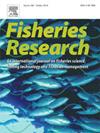Key role of fisheries genomics to support conservation, fisheries management and trade of widely-distributed spiny lobsters
IF 2.2
2区 农林科学
Q2 FISHERIES
引用次数: 0
Abstract
The ornate spiny lobster Panulirus ornatus is a widely-distributed crustacean species that is socio-economically important to Indigenous and local communities. We draw on evidence from regionally abundant populations to refute published comments that P. ornatus is globally endangered based on its conservation listing in China. Recent research to sequence the chromosome-level genome of this prized fishery species in southern China corroborates understanding of fine-scale genetic structure throughout the Indo-West Pacific Ocean. This may be useful in supporting cost-effective conservation and fisheries management, such as to identify point-of-origin along supply chains. Genetic approaches to differentiate between spiny lobster stocks complements the suite of management information used to establish provenance of lobsters. Conservation efforts benefit from the ability to identify wild-caught lobster that originates from sustainably managed fisheries (e.g., Torres Strait) rather than depleted or recovering stocks, thereby shifting demand away from overfished stocks to support instead trade of sustainably-managed fisheries.
渔业基因组学在支持广泛分布的龙虾的养护、渔业管理和贸易方面的关键作用
华丽的多刺龙虾是一种广泛分布的甲壳类动物,对土著和当地社区具有重要的社会经济意义。我们利用区域丰富种群的证据,反驳了基于其在中国被列入保护名单而发表的全球濒危言论。最近对中国南部这一珍贵渔业物种的染色体水平基因组测序的研究证实了对整个印度-西太平洋精细遗传结构的理解。这可能有助于支持具有成本效益的养护和渔业管理,例如确定供应链上的原产地。区分多刺龙虾种群的遗传方法补充了用于确定龙虾来源的一整套管理信息。能够识别来自可持续管理渔业(如托雷斯海峡)而不是枯竭或恢复的种群的野生捕捞龙虾,从而将需求从过度捕捞种群转移到支持可持续管理渔业的贸易,从而使保护工作受益。
本文章由计算机程序翻译,如有差异,请以英文原文为准。
求助全文
约1分钟内获得全文
求助全文
来源期刊

Fisheries Research
农林科学-渔业
CiteScore
4.50
自引率
16.70%
发文量
294
审稿时长
15 weeks
期刊介绍:
This journal provides an international forum for the publication of papers in the areas of fisheries science, fishing technology, fisheries management and relevant socio-economics. The scope covers fisheries in salt, brackish and freshwater systems, and all aspects of associated ecology, environmental aspects of fisheries, and economics. Both theoretical and practical papers are acceptable, including laboratory and field experimental studies relevant to fisheries. Papers on the conservation of exploitable living resources are welcome. Review and Viewpoint articles are also published. As the specified areas inevitably impinge on and interrelate with each other, the approach of the journal is multidisciplinary, and authors are encouraged to emphasise the relevance of their own work to that of other disciplines. The journal is intended for fisheries scientists, biological oceanographers, gear technologists, economists, managers, administrators, policy makers and legislators.
 求助内容:
求助内容: 应助结果提醒方式:
应助结果提醒方式:


